The embodiment of both strength and grace, the sulcata tortoise (Centrochelys sulcata) is an amazing creature. Also known as the African spurred tortoise, this gentle giant is impressive as a full-grown adult, but unbelievably cute as a baby. In this article, we’ll explore 10 amazing facts about baby sulcata tortoises, and of course, lots of adorable pictures!
1. Baby Sulcata Tortoises Live in Africa
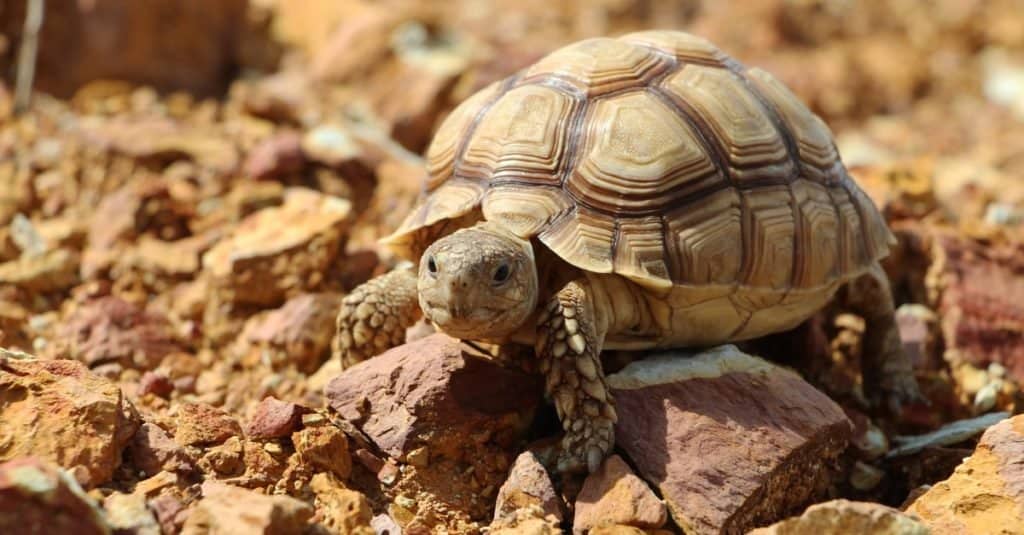
Sulcata tortoises have unique wrinkles or furrow patterns on their shells.
©seasoning_17/Shutterstock.com
Native to Africa, baby sulcata tortoises are found in the Sahara Desert and the Sahel. They often live in flat areas with tall grasses or shrubs, stable dunes, hills, and grasslands. These areas can reach scorching temperatures over 100 degrees Fahrenheit, but sulcata tortoises spend especially hot days safely tucked in their underground burrows.
“Sulcata” means “furrowed” and refers to the grooved patterns on their shells. Sulcata tortoises are also called African spurred tortoises and spur thigh tortoises, which refer to spurs on their back legs.
2. Baby Sulcata Tortoises Are Tiny
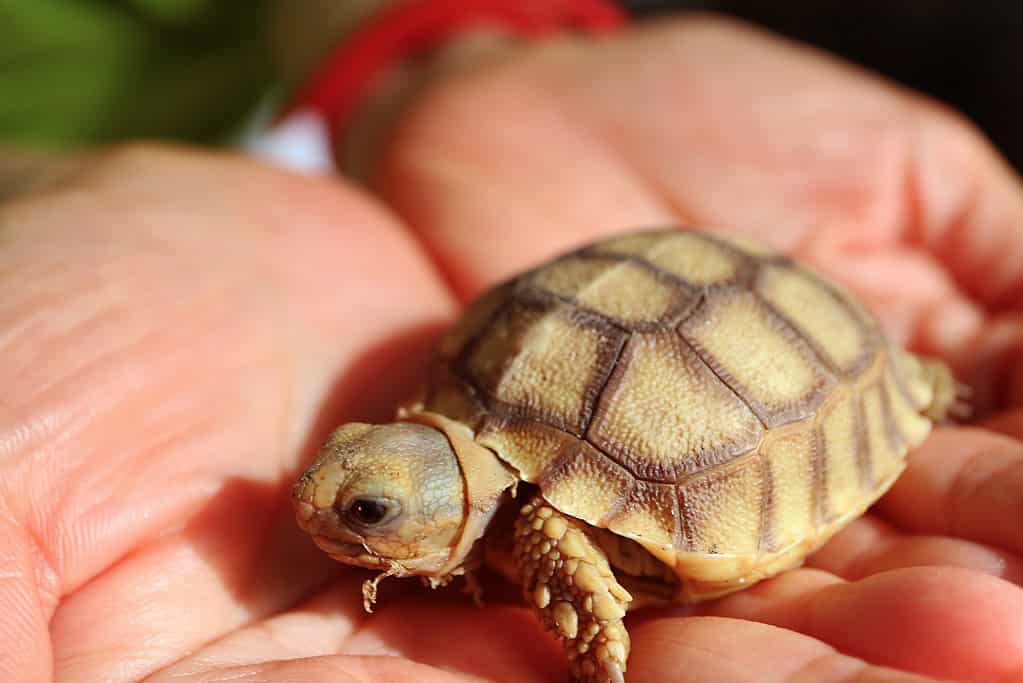
When they hatch, baby sulcata tortoises are incredibly tiny!
©lovelypeace/iStock via Getty Images
Approximately 60 days after mating, female sulcata tortoises search around as they try out several different nesting sites. Once a female tortoise chooses the perfect place to lay her eggs, she digs a hole in the ground. Depending on how dry the area is, the soil might be very hard and dry, and the hole can take up to five hours to dig!
Once the hole is complete, the female tortoise lays one egg every three minutes, filling the nest with 15 to 30 eggs. She covers the eggs with dirt and leaves them to incubate on their own. When the baby tortoises hatch eight months later, they measure just 2 to 3 inches long!
3. Baby Sulcata Tortoises Grow into Gigantic Adults
They may start out life on a minuscule scale, but baby sulcatas grow very quickly. In just their first year, these cute babies grow to be 6 to 10 inches. After that, they just keep on growing and growing. In fact, the sulcata tortoise is the largest mainland tortoise species in the entire world! In addition, it is also the third largest tortoise species in the world, just behind the Galapagos and the Aldabra giant tortoise.
So, just how big can a sulcata tortoise get? When they are fully grown, sulcata tortoises are 24 to 30 inches long and weigh an incredible 80 to 110 pounds. Even more astounding is that male sulcata tortoises have been known to grow even bigger — up to 200 pounds!
4. Sulcata Tortoises Can Live a Very Long Time
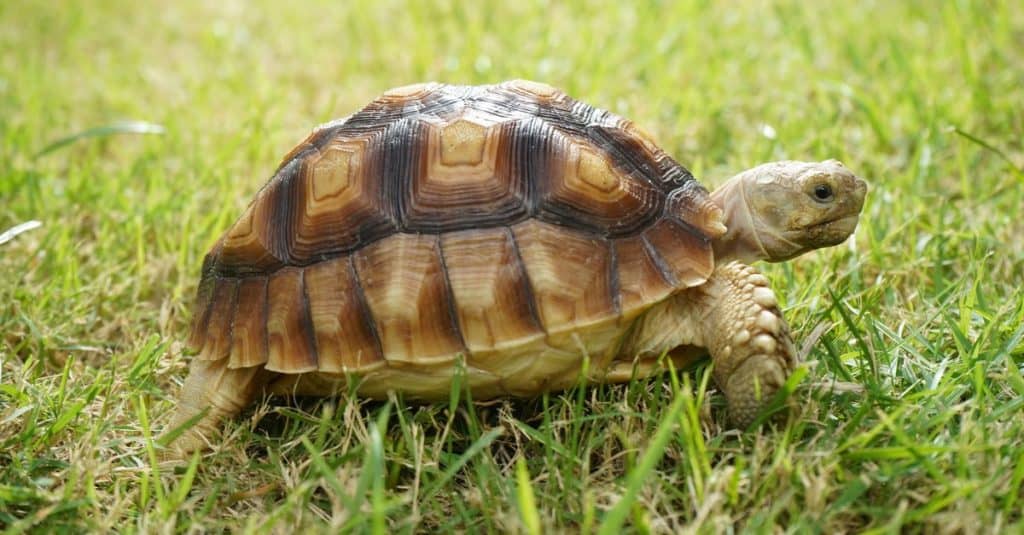
Moving slowly helps sulcata tortoises conserve energy in their harsh environments.
©Sutthiphong Chandaeng/Shutterstock.com
Although they grow rather quickly, baby sulcata tortoises take quite a while to reach adulthood. Sulcata tortoises do not reach sexual maturity until they are 10 to 20 years old! In captivity, these gentle giants live for 54 years on average, but in the wild they may live much longer. Researchers believe that sulcata tortoises can live to be more than 80 years old!
5. Baby Sulcata Tortoises Are Amazing Diggers

The sulcata tortoise is only species still on earth from the genus
Centrochelys.©Somedaygood/iStock via Getty Images
Adult tortoises are rather slow, but baby sulcatas are always on the move. They have adorable, stubby legs that are perfectly equipped for digging — and they love to dig! Living in the hot deserts of Africa, sulcata tortoises use their super-powered digging skills to build underground burrows, which provide a nice place to cool off. Outside temperatures can reach up to 120 degrees Fahrenheit, but tucked safely away in their underground burrows, sulcata tortoises enjoy a cool environment of just 70 degrees Fahrenheit!
Most burrows are about 30 inches deep, but sulcata tortoises can also build large tunnel systems that can be more than 10 feet long! These burrows are vital to the tortoises’ survival, providing a safe cool place that helps to keep them from drying out in the desert.
6. Baby Sulcata Tortoises Have Ginormous Appetites
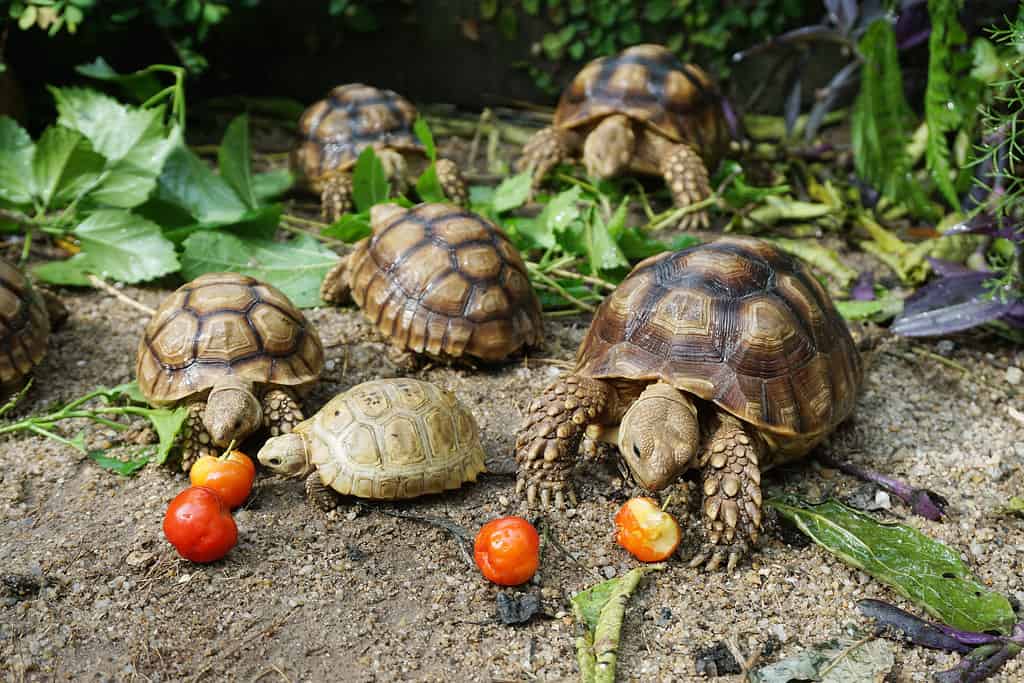
Sulcata tortoises need high-fiber diets.
©Somedaygood/iStock via Getty Images
Sulcata tortoises do not care for their young, so the babies must find food themselves. Fortunately, baby sulcatas hatch from their eggs ready to take on the world, despite their tiny size. They are herbivores, which means that they mainly eat plants. The main part of their diet is made up of grass, and sulcatas will graze grass almost all day long! Since these tiny tortoises will grow up to such a tremendous size, they need lots and lots to eat.
They spend most of their time grazing and eating, depending on the temperature. In the hottest parts of the day, sulcatas burrow underground for some much-needed cool air and moisture. During the cooler parts of the day, they slowly explore the world above ground and graze on plants. This includes grass, cactus pads, flowers, leaves, vegetables, fruits, and leafy greens. One of their absolute favorite snacks, however, is dandelions.
7. Baby Sulcatas Can Regulate Their Bathroom Needs
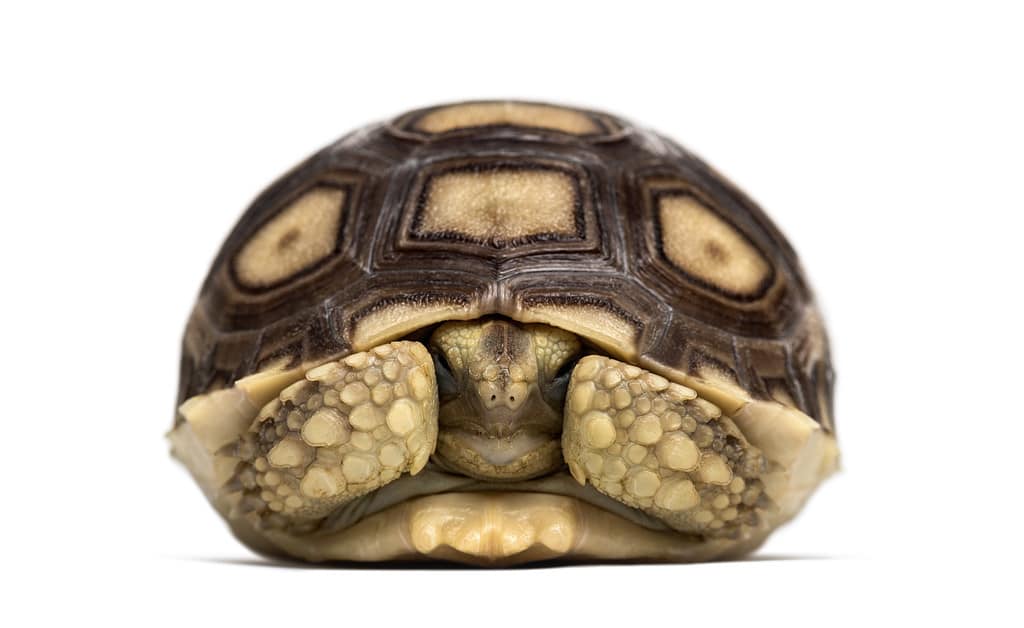
When they feel threatened, sulcata tortoises pull their heads into their shells, protecting their faces.
©GlobalP/iStock via Getty Images
Baby sulcatas have well-adapted bodies built to survive the harsh conditions of their environment. They do not need a lot of water and get most of what they need through their food. This is very useful when living in a desert since water is a scarce commodity!
In addition, baby sulcatas have a very special adaptation that allows them to regulate when they urinate. That’s right, a sulcata tortoise can choose when it needs to go to the bathroom! That way, the tortoise does not lose too much water from urination and gets dehydrated.
8. Some People Keep Baby Sulcata Tortoises as Pets
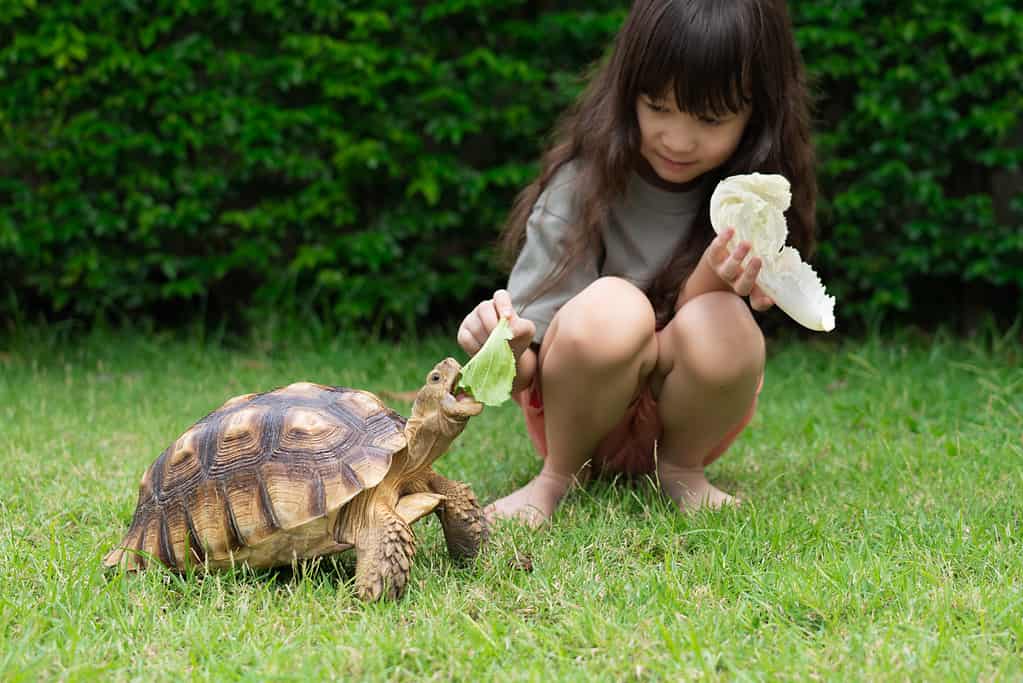
Adolescent sulcata tortoises are pretty big, but they still have a long way to go to reach their full size!
©Shutthiphong Chandaeng/iStock via Getty Images
In general, baby sulcata tortoises are slow and docile, and can be quite friendly and personable with humans. Because of this, many people keep them as pets. However, sulcata tortoises have many unique needs that make it very difficult to keep. As we already discussed, sulcata tortoises are super-powered diggers, so they need lots of dirt and underground space to burrow. In fact, it’s not uncommon for a pet sulcata tortoise to escape the backyard or enclosure where it lives. They can cause a lot of damage to gardens, yards, and even the foundation of a house due to their relentless digging!
In addition, these enormous tortoises love to explore and can quickly get themselves into all kinds of trouble. Their adventurous behavior also makes them susceptible to flipping over on their backs. And of course, the bigger they grow the harder it will be for you to help your tortoise flip back over! Moreover, due to their extremely long lifespans, sulcatas are an expensive, long-term commitment, and can even outlive many of their owners.
And of course, sulcata tortoises are not small pets, which makes them very difficult to house and care for. Just imagine trying to get a giant sulcata tortoise into your car to take it to the vet! They also do not like to be handled, and too much can cause stress and lead to premature death.
9. Sulcata Tortoises Are Endangered

Various reintroduction programs are in place to increase the population of sulcata tortoises in the wild.
©Narong KHUEANKAEW/iStock via Getty Images
Sadly, sulcata tortoises in the wild face many threats and challenges, and the International Union for Conservation of Nature (ICUN) updated their status to endangered in 2020. Unfortunately, their decline is partially due to the fact that people like keeping them as pets. Poachers hunt and capture them from the wild for the international pet trade.
In addition, wild sulcata tortoises compete with cattle for grass and continually lose their resources as wild environments are converted into farmland. Habitat loss and fragmentation, along with climate change, are volatile threats to sulcata tortoises in the wild as well. Wildfires also add to their struggles, wiping out large portions of grasslands where the tortoises graze. Moreover, some humans hunt sulcata tortoises and collect their eggs for food.
10. Sulcata Tortoises Are Important Keystone Species

Although they are herbivores, sulcata tortoises should never eat spinach, kale, broccoli, and parsley.
©Somedaygood/iStock via Getty Images
As expert excavators, sulcata tortoises dig large burrows to protect themselves from the sweltering heat of the desert. These subterranean sanctuaries offer safe environments that are up to 50 degrees cooler than the scorching temperatures above ground. Even after a tortoise has moved on to a new spot, however, their former real estate does not go to waste. Instead, abandoned sulcata tortoise burrows also serve as vital shelters for many other wildlife species.
Other animals often claim and repurpose the abandoned tortoise burrows for themselves, particularly those who cannot dig their own underground refuges. Because of this, baby sulcata tortoises play a crucial role as a keystone species. They shape and influence the ecosystems they are part of and are vital to their environment.
The photo featured at the top of this post is © Somedaygood/iStock via Getty Images
Thank you for reading! Have some feedback for us? Contact the AZ Animals editorial team.







